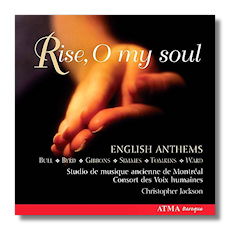
The Internet's Premier Classical Music Source
Related Links
-
Bull Reviews
Gibbons Reviews
Tomkins Reviews - Latest Reviews
- More Reviews
-
By Composer
-
Collections
DVD & Blu-ray
Books
Concert Reviews
Articles/Interviews
Software
Audio
Search Amazon
Recommended Links
Site News
 CD Review
CD Review
Rise, O My Soul

English Anthems
- Orlando Gibbons:
- all true faithful hearts
- See, see the word is incarnate
- Glorious and powerful God
- Fantasia à 3 #1
- John Ward: Prayer is an endless chain
- Thomas Tomkins:
- Sing unto God
- Above the starrs my saviour dwells
- Two Fantasias
- John Bull: Almighty God, which by the leading of a star (The Star Anthem)
- William Simmes: Rise, O my soul
Consort des Voix humaines
Studio de musique ancienne de Montréal/Christopher Jackson
Atma Baroque ACD2-2506 DDD 60:39
These anthems were associated with England's "Chapel Royal" between 1600 and 1640 – an era that began, essentially, with the death of Queen Elizabeth I. Elizabeth did much to make the Chapel Royal into an establishment in which Anglican sacred music thrived, and it continues to do so even today. By the first part of the 1600s, the musical contingent included dozens of singers (men and boys), instrumentalists, and composers. Sometimes these musicians also participated in musical entertainments outside of the Anglican service.
Anthems were sung during the course of church services, often but not exclusively during important occasions. The texts were always in English (from the Bible, or The Book of Common Prayer), and the music was not sung by the congregation (whose members restricted themselves to psalms and hymns) but by the musicians employed within the Chapel Royal. There are two types of anthems: the "full anthem," which was unaccompanied and generally for the full chorus, and the later-developing "verse anthem," in which passages for solo voices were introduced to alternate with those for full chorus, and which were accompanied by an organ, a consort of viols, or both. With the exception of the instrumental fantasias by Gibbons and Tomkins, all of the works on this CD are verse anthems. All utilize a five- or six-part chorus, in addition to several soloists, plus a viol consort and organ. Although the polyphony is sober, as befits the seriousness of the texts, the writing is consistently graceful and frequently beautiful, and also emotionally rich.
These Quebec-based musicians do not shy away from bringing out the emotion in the music. In William Simmes' Rise, O my soul, for example, one can hear the singers aspiring to eternal life in God. There's nothing cold about these performances. Stylistically, there's just a touch of the French Baroque to them – perhaps it's the fact that the music almost seems to dance, at times, and that extremes of volume and phrasing are downplayed, creating softer musical contours. It might be best to play this CD by candlelight, as was probably the case when this music was first heard! There are four sopranos, three altos, three tenors, and three basses in the Studio de Musique Ancienne de Montréal, although the group sounds larger, probably because of the richly reverberant recording venue – the Église Saint-Augustin de Mirabel in Quebec. There are no boys (I assume that alto Daniel Cabena is an adult, anyway), but the women produce tones that give all the benefits of boys without the drawbacks. There are five viol players and one organist.
Atma's booklet contains a good essay and sung texts, both in French and English. (A good thing, because the words aren't always clear.) You can choose to appreciate the program as an intellectual experience, but I expect that its beauty eventually will carry you away.
Copyright © 2008, Raymond Tuttle




















